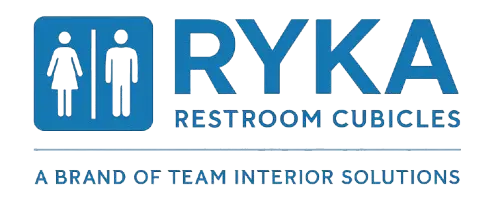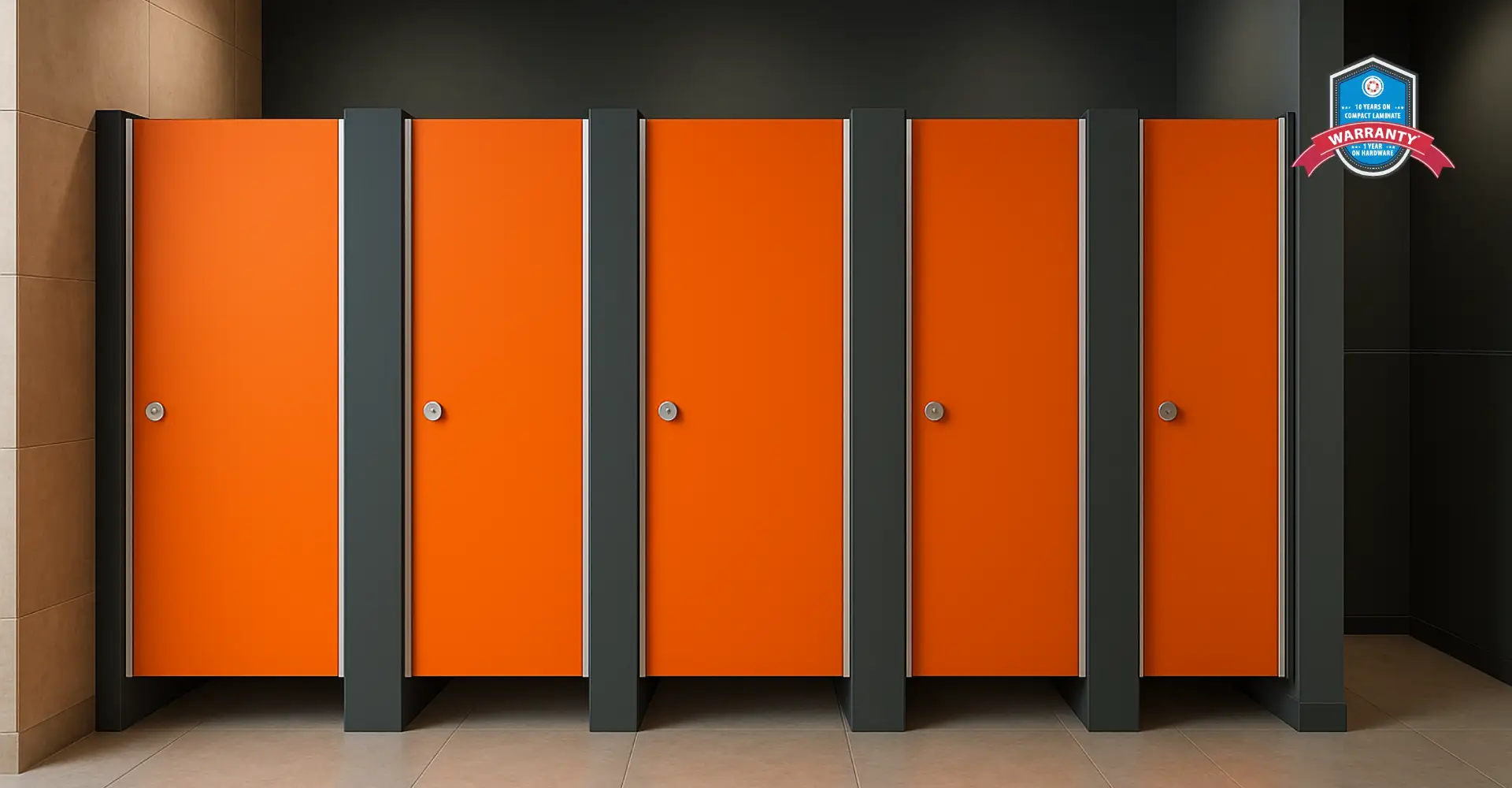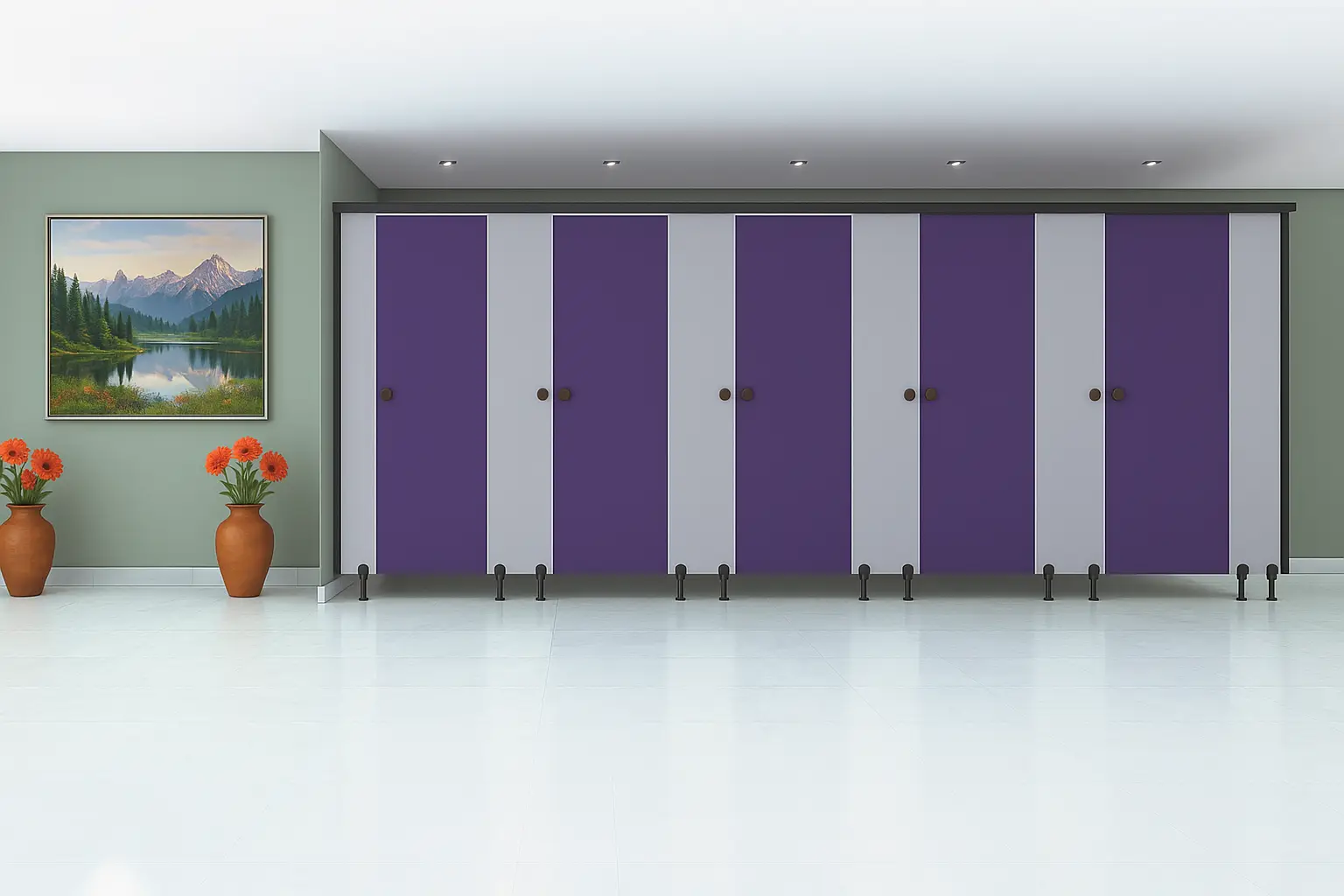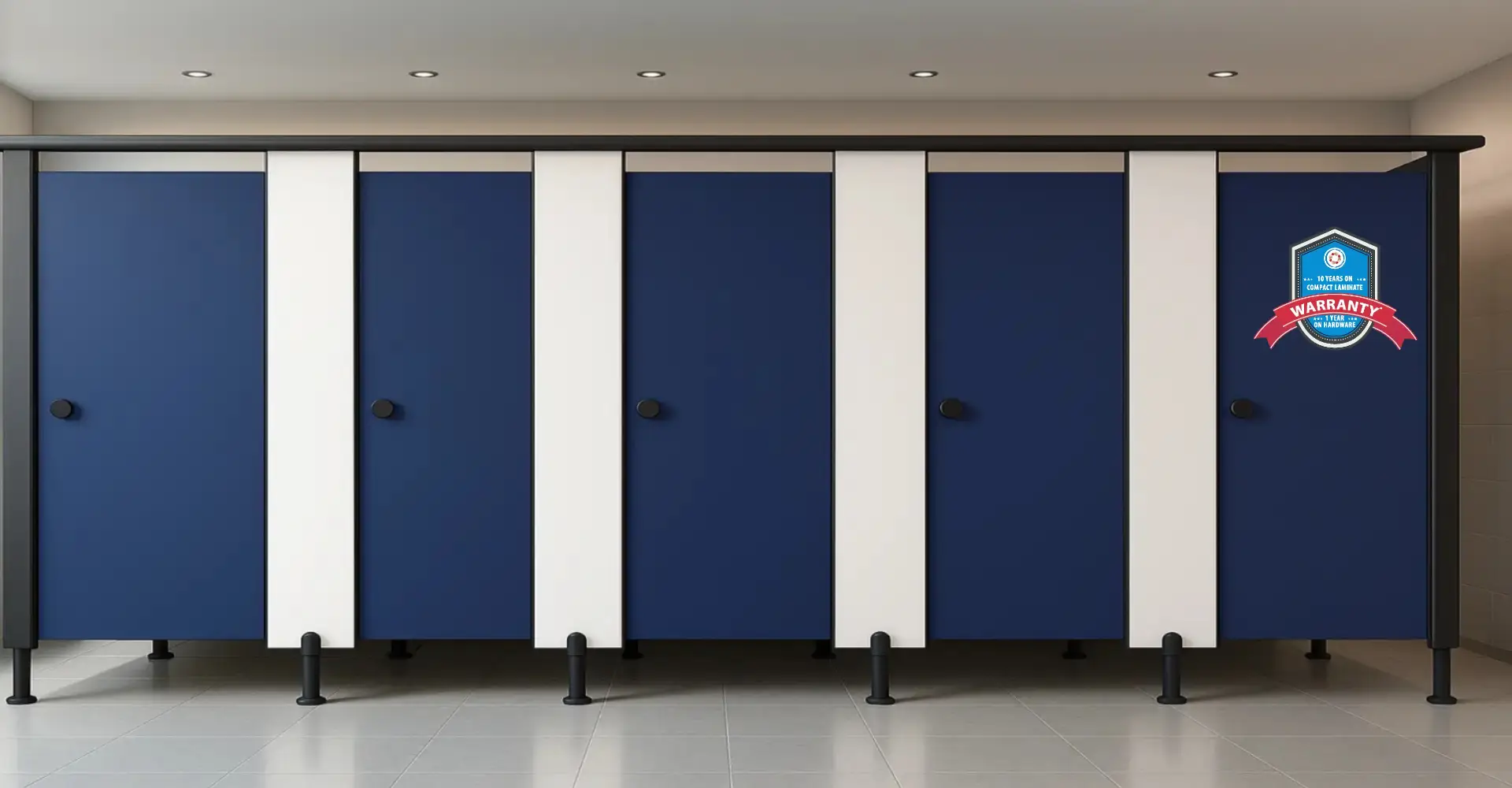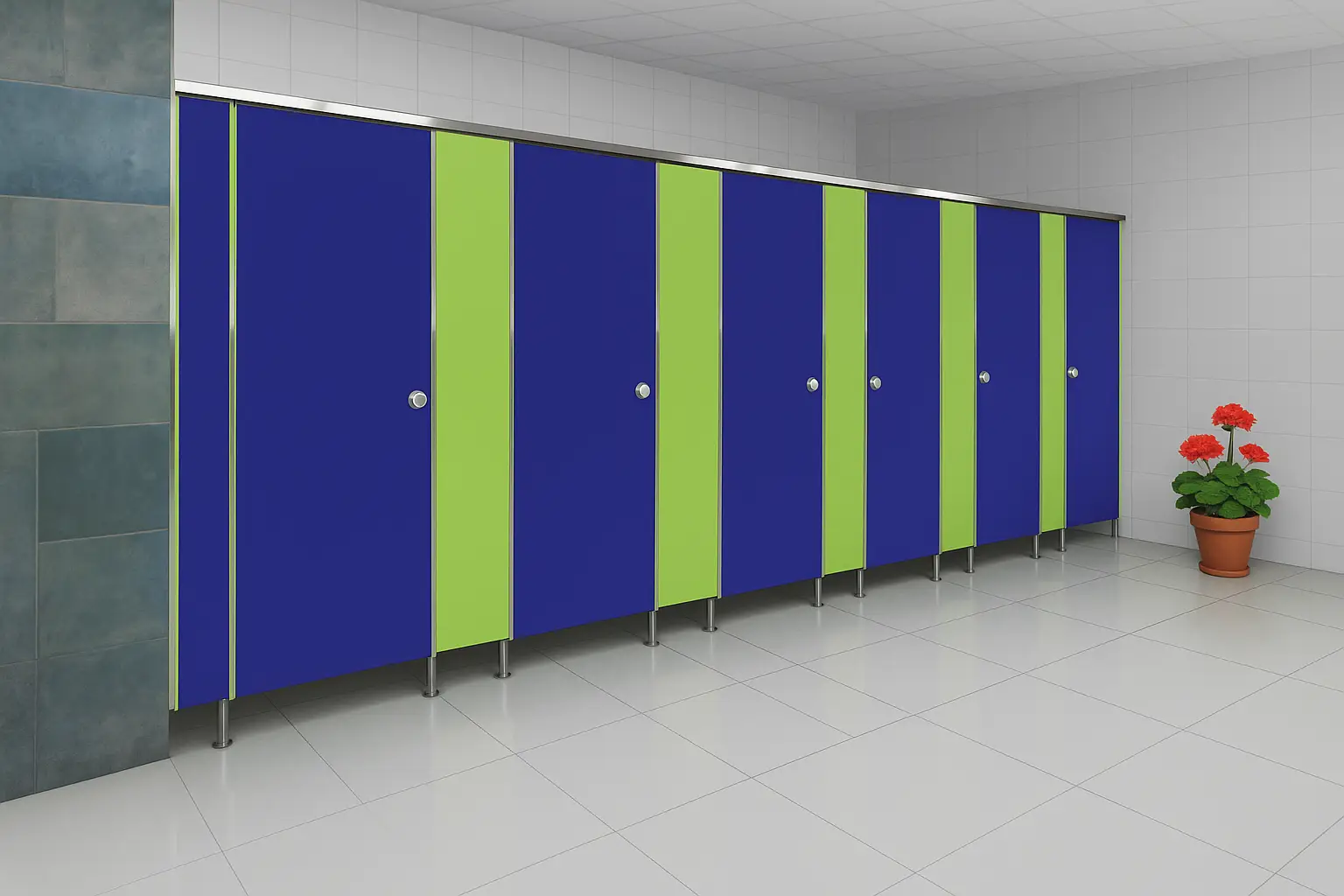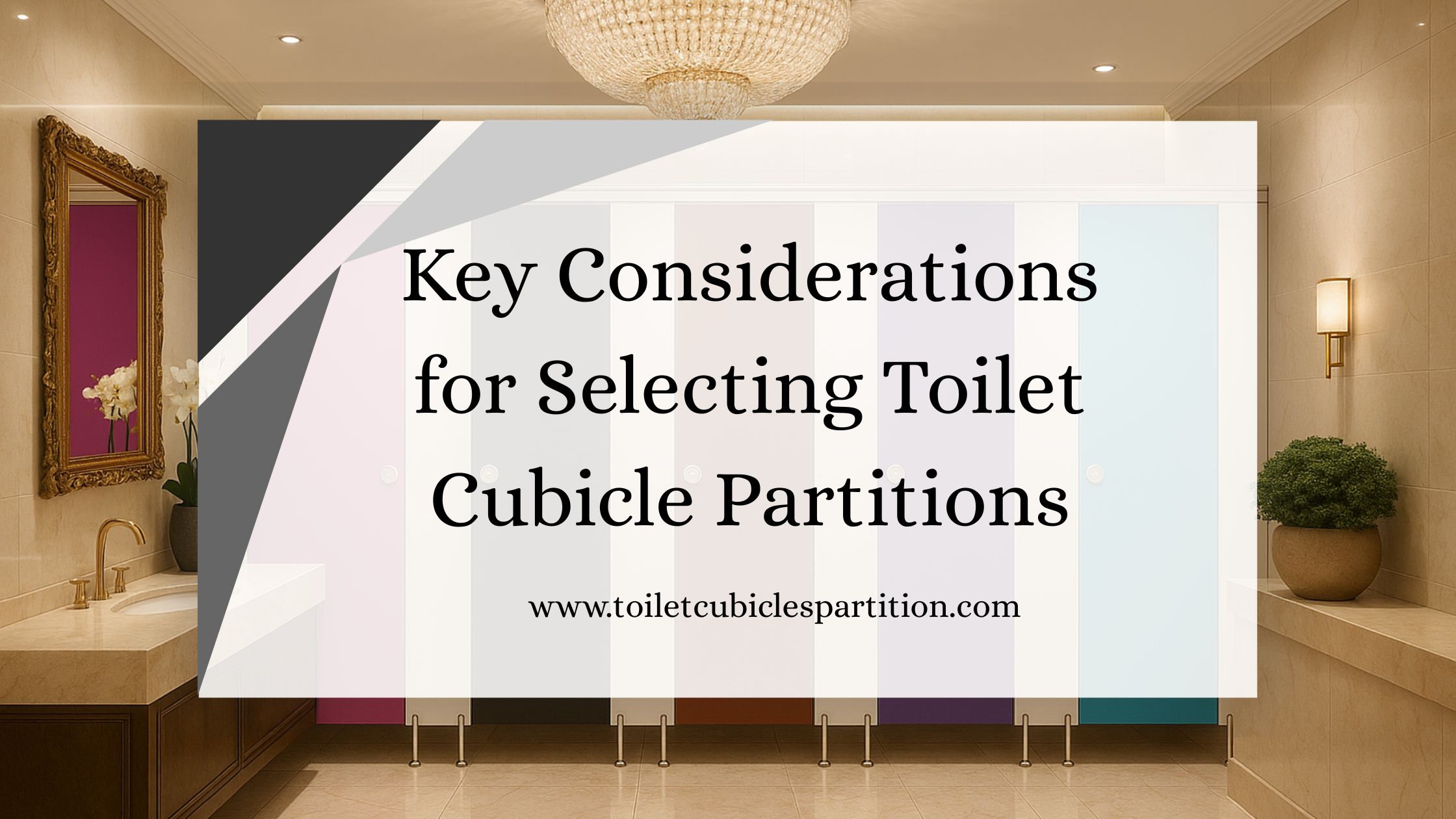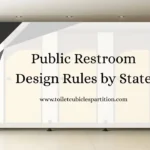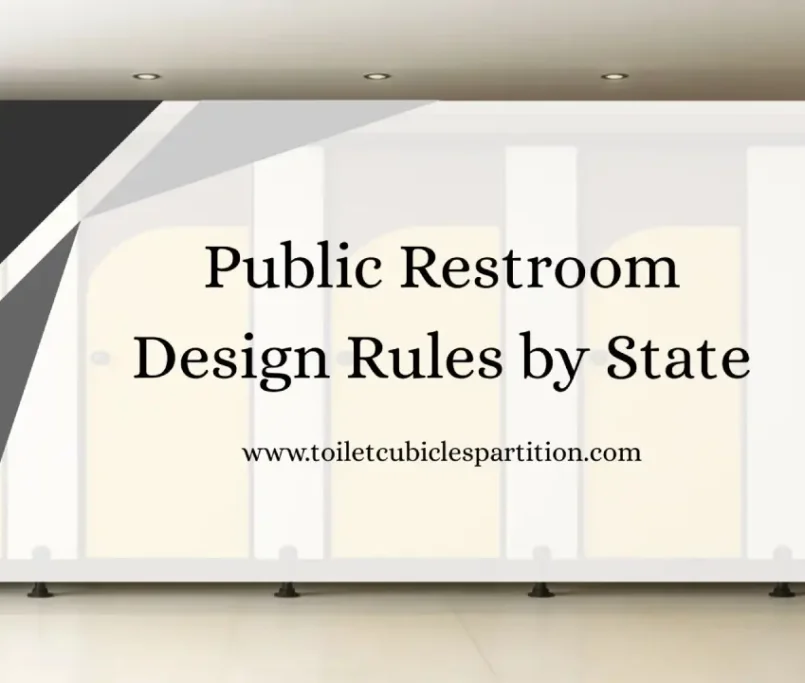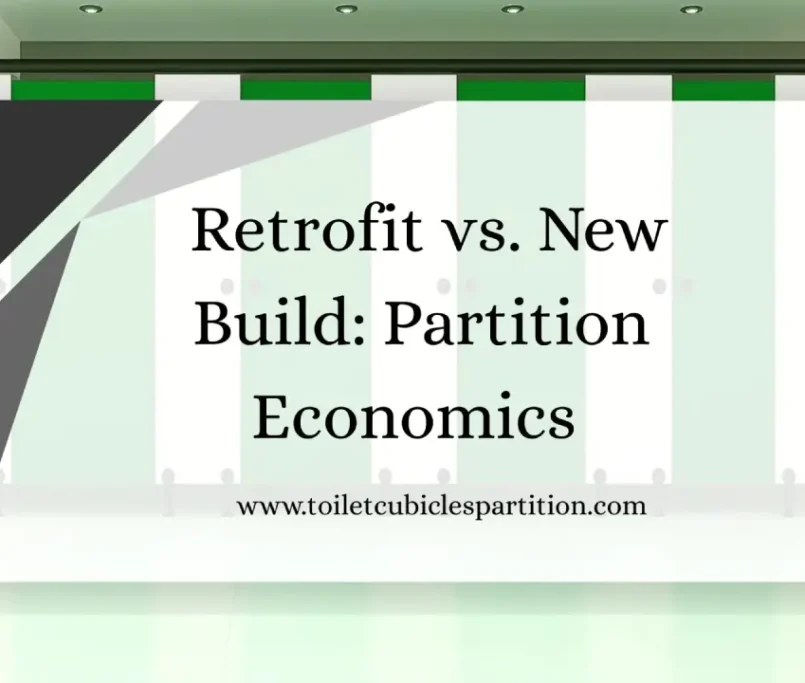In case of selecting toilet cubicle partitions, you may ask: What are the best partitions in my office or school? The choice of the appropriate partitions is not only about the appearances, but also the direct impact on hygiene, privacy, comfort, safety, and even property value. Making bad decisions may result in repairs, dissatisfied users, and a bad reputation for your facility. In contrast, properly planned partitions can ensure that your bathrooms will be comfortable, safe, and durable, and facilitate accessibility and ROI growth.
Being a reliable Toilet Cubicles Partitions Manufacturer, Ryka Restroom Cubicles offers solutions that offer quality in terms of long-life, appearance, and eco-friendliness. We design partitions to suit modern standards and endure over the years, regardless of whether it is a hectic corporate office, a hospital, a school, or a civic facility.
In this guide, we’ll answer questions you might actually ask out loud:
- “What are the most durable toilet partitions for high-traffic areas?”
- “How can I make restroom cubicles more private and comfortable?”
- “Which materials are easiest to maintain?”
- “How do I make my restrooms accessible for everyone?”
We’ll cover:
- Materials and durability considerations
- Privacy and comfort features
- Safety and accessibility standards
- Aesthetic and branding opportunities
- Cost, maintenance, and property value impact
- Smart restroom and sustainability options
On the way to it, there are also links to useful topics, such as Retrofit vs. New Build: Partition Economics to install and budget, Inclusive Cubicles Benefit Modern Workplaces to ideas of accessibility, and Hardware Innovations: Designer Hinges and Locks to learn about the latest in partition hardware.
At the conclusion of this guide, you will be able to select toilet cubicle partitions that are effective, attractive, inclusive, and durable–that way, your bathrooms will be convenient and modern.
1. Why Toilet Cubicle Partitions Matter
Privacy and Comfort in Restrooms
The question that many facility managers and designers will ask themselves is, Why do I pay to install full-height toilet cubicles? It is not complex: full-height partitions provide the highest privacy and minimize noise, and help users get a sense of safety. In the case of a corporate office, a hospital, an airport, or a luxury hotel, such partitions make the environment more comfortable for employees, patients, or visitors.
As an example, a corporate office would renovate its restrooms with full-height partitions. Following the transformation, noise complaints significantly reduced by 60 percent, and employees complained that they felt much more relaxed during breaks. This demonstrates how proper investment in the height of partitions and the quality of locks can directly affect user satisfaction.
Facility managers will also be able to reduce distractions by deriving a sense of privacy and make the restroom environment safe and professional by using full-height partitions.
Hygiene and Maintenance
One of the questions that is frequently asked is, what are the easiest to maintain and keep hygienic toilet cubicle materials? Partitions were important in ensuring hygiene through isolation of spaces, minimizing cross-contamination, and ensuring efficient cleaning.
Phenolic and compact laminates are non-porous, water-resistant, and easily wiped clean, and hence they can enable facilities to maintain high hygiene standards with minimum effort.
Case Study: A hospital that is privately owned substituted the old metal cubicles with small laminate partitions. The outcome was spectacular: the cleaning effectiveness was increased by 35 percent, and the infection control scores were also elevated significantly. This shows that the appropriate material selection will not only ensure that the restrooms are kept clean, but that there is also an improvement in the efficiency of operations.
Safety Considerations
The other argument that most frequently gets asked is: how can toilet cubes be safe for everybody? The rounded edges, anti-slippery flooring, and easy-to-operate locks promote safety in places such as schools, gyms, and hospitals, and prevent accidents. Strong partitions have the power to last through the daily hard usage, yet they are also safe and accessible.
In facilities that will take it one step further, facilities that are accessibility-based will offer inclusive restroom designs, so that all users can comfortably use the facilities. Find additional information on accessibility upgrades in Inclusive Cubicles Benefit Modern Workplaces.
2. Material Selection: Durability, Maintenance, and Hygiene
The most popular question that facility managers provide is as follows: Which toilet cubicle material will last longest and be the easiest to maintain? Selection of the material should be based on durability, hygiene, and cost. Various materials are applied to various environments based on traffic, moisture levels, and maintenance requirements.
Phenolic Partitions
Phenolic partitions are highly resilient, wear and tear-free, and waterproof, which makes them ideal in places of heavy traffic such as airports, malls, and corporate offices.
Case Study: A global airport placed phenolic partitions in all the restrooms. In a period of five years, the maintenance expenses fell by 40 percent, and the satisfaction level of passengers had increased considerably. This demonstrates that even though the cost of phenolic partitions might be more expensive in the short run, the benefits of the long-term savings and longevity will make it an intelligent investment.
Compact Laminate Partitions
This is the question many people ask: Are there hygienic and easy-to-maintain partitions? The solution would be a compact laminate. These are waterproof, mold-resistant, and easy to clean, and hence ideal in hospitals, gyms, and schools.
Case Study: One of the chains of gyms changed old metal cubicles to small laminate ones. The amount of time that was spent cleaning was reduced by 25 percent, and the number of complaints of a hygienic nature went down drastically, which confirms that the choice of material has a direct influence on the level of cleanliness and satisfaction of the user.
Metal Partitions
The use of metal partitions is economical and durable, though it will need frequent upkeep to avoid corrosion. They would be most appropriate in medium-traffic spaces where cost is a major factor.
Facility managers also usually opt to use metal partitions when the budget constraint is critical at the beginning, yet it must be weighed against long term maintenance expenses.
High-Pressure Laminate (HPL)
HPL partitions combine design flexibility and durability. They are sleek, customizable, and well-suited to offices, boutique hotels, or other high-end environments where looks matter.
HPL is a good option in case you want partitions that add visual value to a restroom and are also sturdy.
Key Considerations When Choosing Materials
When deciding which material to use, consider:
- Traffic volume: High-traffic areas benefit from phenolic or compact laminate
- Moisture exposure: Wet areas need water-resistant partitions
- Maintenance capabilities: Choose materials that reduce cleaning time and labor
- Budget vs. long-term ROI: Higher upfront costs may save money over time
For more insights on cost, installation, and planning, see Retrofit vs. New Build: Partition Economics.
3. Privacy and Comfort Features
Facility managers often pose the question when they are designing restrooms: How can toilet cubicles be made more intimate and comfortable to the users? The partition height, door hardware, and acoustic design are several important things to take into account.
Partition Height
One of the biggest factors affecting privacy is partition height. Full-height partitions provide maximum privacy, reduce noise, and create a more comfortable restroom experience. They are particularly important in corporate offices, airports, and premium hotels, where user satisfaction is closely tied to the overall environment.
By installing full-height partitions, facilities can also minimize distractions and increase the sense of personal space for employees, guests, or visitors.
For a deeper dive into privacy solutions, explore Full-Height Cubicles: Creating Total Privacy.
Door Hardware
Another crucial factor is door hardware. Modern hardware not only improves usability but also enhances aesthetics. Features like soft-close doors prevent slamming, while designer hinges and advanced locks ensure both safety and style. Indicator locks add convenience by letting users know if a cubicle is occupied, further reducing frustration.
Investing in high-quality hardware creates a seamless user experience and elevates the overall impression of the restroom.
Learn more about hardware innovations in Hardware Innovations: Designer Hinges & Locks.
Acoustic Comfort
Noise can be a significant concern in busy restrooms. Partitions with minimal gaps and acoustic panels absorb sound and reduce echo, creating a quieter, more comfortable environment. This is especially valuable in open-plan offices, airports, and public spaces where multiple users are present simultaneously.
By combining the right partition height, hardware, and acoustic features, facilities can create restrooms that feel private, safe, and pleasant for everyone.
4. Safety and Accessibility
When facility managers plan restroom spaces, a common question is: “How can I make toilet cubicles safe and accessible for everyone?” Safety and accessibility go hand in hand, especially in high-traffic or public environments.
Anti-Slip Surfaces and Rounded Edges
One of the simplest ways to prevent accidents is by using anti-slip flooring and rounded edges on partitions. These features are particularly important in wet or high-traffic areas such as gyms, hospitals, schools, and sports facilities. By minimizing the risk of slips and bumps, facilities can protect users and reduce liability.
ADA Compliance
Accessibility is not just a regulatory requirement—it’s also about creating an inclusive environment. ADA-compliant cubicles feature wider stalls, grab bars, and proper placement of toilets and sinks, making them usable for people with mobility challenges or disabilities.
Ensuring that your restrooms are fully accessible benefits everyone, from employees and students to patients and visitors, while keeping your facility compliant with legal standards.
Learn more about inclusive restroom design in Inclusive Cubicles Benefit Modern Workplaces.
Hygiene Benefits
Safety and accessibility also tie into hygiene. Non-porous surfaces on partitions resist mold, bacteria, and water damage, making cleaning faster and more effective. High hygiene standards not only protect users but also reduce maintenance costs over time.
By combining anti-slip features, accessibility design, and hygienic surfaces, facilities can create restrooms that are safe, inclusive, and easy to maintain—an approach that benefits both users and facility managers.
5. Aesthetic and Branding Opportunities
A question many facility managers ask is: “How can toilet cubicles contribute to overall design and branding?” The right partitions do more than provide privacy—they can enhance the visual appeal of a restroom and reinforce a brand’s identity.
Choosing the Right Colors and Finishes
The color and finish of cubicles play a big role in the overall atmosphere:
- Neutral tones are ideal for corporate offices, creating a professional and clean look.
- Bright, playful colors work well in schools, daycare centers, or childcare facilities, making restrooms more inviting for children.
- Wood-grain laminates give hotels, executive spaces, and premium offices a luxurious feel, combining elegance with durability.
Custom Branding Opportunities
Partitions can also be customized with logos, patterns, or textures, helping to reinforce corporate branding or create a distinctive visual identity. Custom designs make restrooms feel intentional and cohesive with the rest of the facility, rather than an afterthought.
Case Study: A multinational corporation installed branded HPL partitions in its office restrooms. Employees reported higher satisfaction with the facilities, and the custom branding subtly reinforced the company’s identity throughout the workspace.
6. Cost, Maintenance, and Property Value
A common question from facility managers and property owners is: “How much should I spend on toilet cubicles, and will it pay off in the long run?” Understanding both upfront costs and long-term benefits is key to making the right decision.
Upfront vs. Long-Term Costs
Metal partitions may seem like the most economical option at first, but they often require more maintenance and replacements over time. On the other hand, phenolic and laminate partitions may have a higher initial cost but deliver long-term savings through durability, easier cleaning, and fewer repairs.
By considering the total cost of ownership, facilities can avoid unexpected maintenance expenses and ensure that restrooms remain functional and attractive for years.
ROI and Property Value
High-quality restrooms do more than improve hygiene and comfort—they can increase tenant satisfaction and overall building value. Modern, well-designed restrooms give a strong impression of professionalism and care, which can boost commercial rental value by up to 15% according to industry studies.
Investing in durable, stylish, and functional partitions is therefore not just about aesthetics or compliance—it’s a strategic decision that adds measurable value to your property.
Learn more about how restroom upgrades impact property value in Top 5 Ways Toilets Increase Property Value.
7. Smart Restrooms and Sustainability
Many facility managers today ask: “How can I make restrooms more sustainable and future-ready?” Smart design and eco-friendly materials are key to creating efficient, hygienic, and environmentally responsible restroom spaces.
Eco-Friendly Materials
One of the first steps is choosing eco-friendly materials. Using recyclable laminates and low-VOC finishes not only reduces environmental impact but also improves indoor air quality. These sustainable options help facilities meet green building standards while promoting a healthier environment for users.
Smart Restroom Integration
Smart technology is transforming restrooms. Sensor-operated faucets, flushes, and lighting improve hygiene, reduce water and energy consumption, and minimize touchpoints. Combining this technology with modular partitions allows for easy replacement or upgrades without the need for a full renovation, saving time and costs over the long term.
Case Study: A corporate campus implemented sensor-operated toilets with modular phenolic partitions. The results were impressive: water usage dropped by 20%, and maintenance requests decreased by 30%, demonstrating both sustainability and operational efficiency.
Learn more about how manufacturers are supporting modern smart restrooms in 4 Ways Toilet Cubicle Manufacturers Are Supporting Smart Restroom Projects.
8. Urbanization and Washroom Standards
Facility planners often ask: “How does urbanization affect restroom design and standards?” As cities grow and urban populations rise, there is greater demand for durable, hygienic, and accessible restroom facilities.
In high-density commercial areas—like office complexes, airports, and shopping centers—restrooms must comply with modern regulations covering privacy, safety, accessibility, and hygiene. Properly designed partitions help facilities meet these standards while handling higher foot traffic efficiently.
Modern urban restrooms also need to accommodate increased usage without sacrificing cleanliness or user comfort, making durable materials, smart fixtures, and full-height partitions more important than ever.
Learn more about evolving washroom standards in urban environments in Urbanization’s Effect on Washroom Standards.
Conclusion
You might be wondering: “What’s the most important thing to consider when choosing toilet cubicle partitions?” The answer is that successful restroom design balances durability, privacy, safety, aesthetics, cost, and sustainability.
Partnering with a trusted manufacturer like Ryka Restroom Cubicles ensures that your facilities are functional, stylish, inclusive, and built to last. By choosing modern materials, full-height partitions, and smart hardware, you can create restrooms that are comfortable, hygienic, and future-ready—a space that benefits both users and the facility itself.
Well-designed partitions aren’t just functional—they leave a lasting impression on employees, visitors, and tenants, while supporting long-term operational efficiency and property value.
